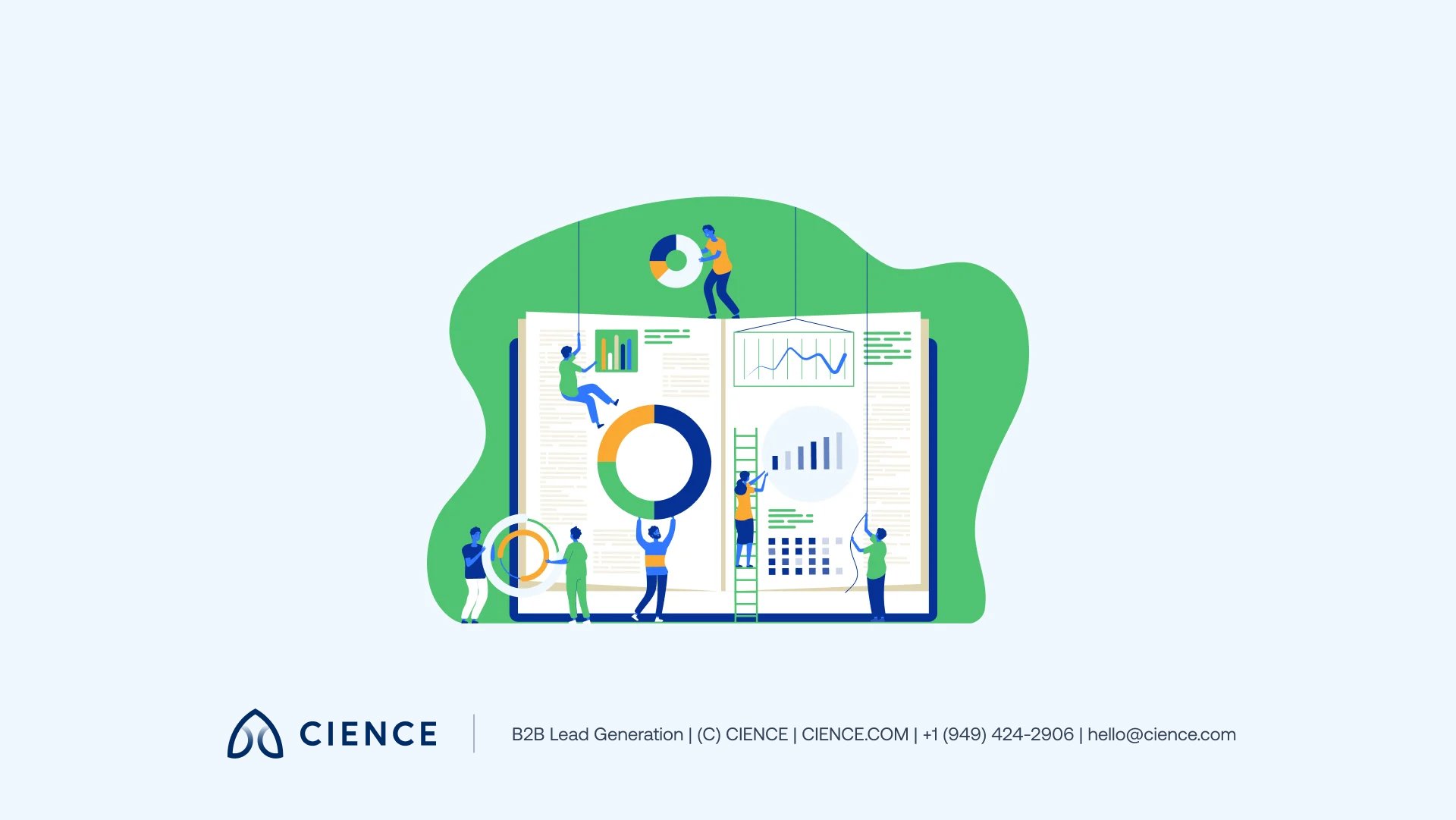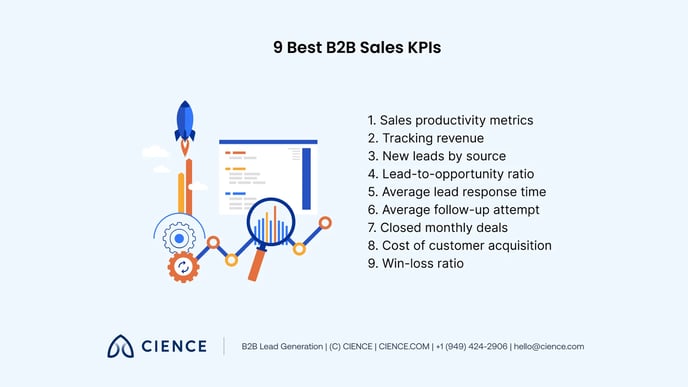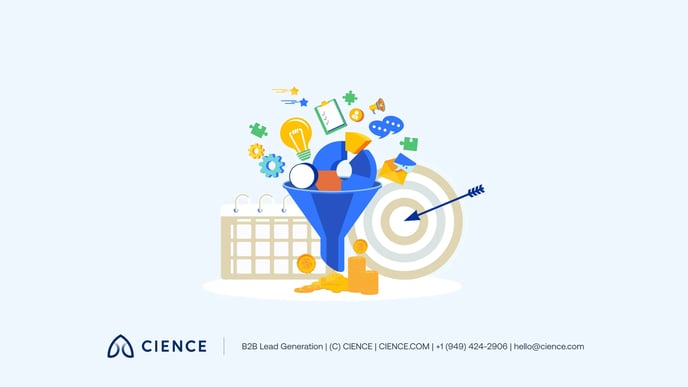9 Best KPIs to Track in B2B Sales
Closing the deal is much harder in today's market than it was just twenty years ago. We have too many channels where we can market our product, from Google to TikTok to email campaigns.
Considering the competition is high in almost every industry, selling your product can be overwhelming at times.
B2B sales take the difficulty level one step further since the stakes are usually much higher and the audience is more rigorous.
It’s definitely harder to stand out, and making fun, social media content for a B2B audience can also prove to be a challenging task since everything you do is scrutinized.
To survive the harsh market race, B2B sales teams need to track their performance—for example, with the help of a monitoring dashboard—to identify their weak spots, see what’s working, and learn where they should improve.
To help you skyrocket your sales goals, we’re providing you with the nine ultimate KPIs to track if you're in a B2B sales business.
What Are B2B Sales KPIs and Metrics?
Business metrics and KPIs are often used interchangeably; however, they are two different terms that shouldn't be confused.
We describe business metrics as the measure that can be quantified and used to track and assess the progress of different business processes. The main reason businesses use metrics is to control and track their spending to increase revenue and assess the progress of their short-term and long-term goals.
On the other hand, a key performance indicator (KPI) is a measure of performance we can quantify over time for specific objectives.
B2B sales teams (or any teams) use KPIs to define and target their goals better, determine progress, and make better decisions.
The main difference between business metrics and KPIs is that KPIs are the measures you take and monitor that have the most impact on your business. They are the ones that clearly state what your organization needs to reach long-term and short-term goals.
Even though business metrics also track your progress and processes, they are not as important as KPIs. They are here to define strategy and provide a clear focus toward reaching the goal. Business metrics are not as critical or urgent.
 9 Best (and Most Useful) B2B Sales KPIs
9 Best (and Most Useful) B2B Sales KPIs
Now that we’ve explained the difference between KPIs and business metrics, let's dive deeper and see which B2B sales KPIs are the most useful and which ones you should track.
1. Sales productivity metrics
Every B2B sales team should measure their productivity. Monitoring and tracking sales productivity will help you understand how much time your business needs to reach its revenue target. The faster the sales reps hit their targets, the higher the company’s sales productivity is.
By measuring, tracking, and, more importantly, understanding this data via managing the team's devices through MDM, the sales team can determine what’s working and what’s not working and think about strategies for improvement. Some things to track the productivity of your sales include:
- The average time spent running demos. It’s essential to know how much time your sales team needs to demonstrate your products to customers. You can calculate this by dividing the number of hours spent demoing with the total number of hours worked and multiplying it by 100.
- Time spent on data entry. Learning how much time your team spends on data entry is important as it shows how much time they spend on repetitive and time-consuming tasks, compared to more rewarding aspects of their job. If your sales team is occupied with data entry versus actually selling services or products you offer, they will be less productive, which defies the purpose of their existence. Furthermore, tracking how much time your team spends on data entry will allow you to improve and streamline processes, for instance, automating some part of it to boost your employees' productivity and success rate.
- Time spent on the phone. This metric shows how much time sales reps spend on the phone with clients to close the deal.
- Percentage of closed deals. This measures how many closed deals resulted in a sale over a specific period. Sometimes it’s easier to have a pre-made contract you can send to the client while it’s still “hot.”
2. Tracking revenue
Sales reps are one of the primary sources behind revenue growth. For that reason, it’s important to track how they close deals and why clients are attracted to their offers. Understanding these two factors will help you improve your overall revenue and retain customers after you close the deal. To understand the revenue growth in a better way, you should track a few things, including:
- Sales volume by location. Sales volume by location shows where there is demand for a product or service and where demand is lacking. This particular KPI will help your sales team customize their strategy to increase sales in those areas where the interest is the lowest.
- Percent of sales discounts. Knowing what percentage of sales discounts are used helps the sales department determine which discounts are most efficient and push those to increase sales.
- The cost of the marketing. This shows how effective your marketing, sales, and advertising campaigns are so you can fine-tune your marketing efforts to match the product price.
- Customer acquisition costs. These costs are essential as it shows how much money you’ve spent to acquire new customers, and this is something investors will closely monitor when making a decision. Overall, the customer acquisition costs show how healthy your business growth is.
3. New leads by source
This KPI metric will show you a few vital tools you can use to scale your business. First, it tells you how much information you have about your new lead. Secondly, it tells you how many leads are going through the pipeline and where they’re coming from.
All of this combined helps you better target your clients and know where to look for them. As an example, if you determine that most of your clients come through your website, as opposed to cold calling, you can, over time, allocate your resources toward your website since it’s the most preferred channel for your customers. If you’re looking to push this number, you can use specific lead gen platforms that help build lead lists.
4. Lead-to-opportunity ratio
The lead-to-opportunity ratio shows how many leads turn into sales opportunities. You can look at this KPI as the effort your sales team makes to qualify a lead and turn it into an opportunity. It's an important metric, as it shows how many opportunities come through your pipeline each month, which will allow you to increase your sales team’s performance over time.
5. Average lead response time
An average lead response time is one of the most critical B2B sales KPIs as it measures the time needed to follow up with an engaged prospect. This KPI shows some of the potential reasons leads are lost (such as having a response time that’s too slow), and it will give insights on the likelihood of a conversion, considering a timely and useful response. The truth is, not every salesperson can write a follow-up email that people respond to, and it’s something that requires attention.
6. Average follow-up attempt
Another important KPI to track is the average follow-up attempt your sales team makes, from their first outreach to the end of the activity. This KPI is important as it shows sales reps’ persistence along with the leads’ interest in the product or service you’re offering. The golden rule is that the fewer follow-ups there are, the higher are the chances of closing the deal. If your salespeople need to take one too many follow-up attempts, you should probably consider better targeting of potential customers.
 7. Closed monthly deals
7. Closed monthly deals
One of the most important KPIs to track is the percentage of your closed-won deals every month. By tracking this number, you’ll be able to set a monthly quota for your sales team in a better way and improve this number as time goes by. Tracking this particular KPI helps you set realistic goals for your team and assess your business finances better, as your revenue depends greatly on their effort.
8. Cost of customer acquisition
The cost of customer acquisition is yet another important KPI your sales team should track as you need to ensure you’re making more than you’re investing. Customer acquisition cost (CAC) is a measure of how much you’ve spent on each lead that is converted into a paying customer.
To calculate your CAC, you can use this formula: CAC = Money spent on client acquisition over a certain period divided by the total number of customers you received during the same period. By monitoring this number regularly, you can see which sales tactic is working and which are not efficient and tweak as needed.
9. Win-loss ratio
Another KPI to be aware of is the win-loss ratio. This is the calculation of won deals over those that are lost. This KPI is vital for business since it provides better insights into why some deals are won and some are lost and determines the next steps.
Knowing which KPIs you should track is good, but knowing how to prioritize them is better since those KPIs will help you determine where to start and how to reach your goals.
To be more specific, we can split your business' goals into two categories: primary and secondary goals. If you decide to organize a webinar, your engagement metrics would be secondary, as they're the ones that help you understand your primary goal of making conversions.
Your primary KPIs will help you improve your sales team’s performance. They are here to help you understand how your team functions and learn what adjustments you need to make to drive growth.
Now, let’s see how you can prioritize and stick to your B2B sales KPIs in the most efficient way.
How to Prioritize (and Stick to) Your B2B Sales KPIs
Knowing which KPIs you should track is good, but knowing how to prioritize them is better since those KPIs will help you determine where to start and how to reach your goals.
To be more specific, we can split your business' goals into two categories: primary and secondary goals. If you decide to organize a webinar, your engagement metrics would be secondary, as they're the ones that help you understand your primary goal of making conversions.
Your primary KPIs will help you improve your sales team’s performance. They are here to help you understand how your team functions and learn what adjustments you need to make to drive growth.
Now, let’s see how you can prioritize and stick to your B2B sales KPIs in the most efficient way.

1. Bring sales and marketing teams on the same page.
If you want to prioritize and stick to your B2B sales KPIs, you need to align your marketing and sales teams and enable them to work together seamlessly.
The first thing you need to do is choose which KPIs are most important for your organization based on the results you want to achieve and determine which department is responsible for their successes or failures.
For instance, let's say your KPI is the number of qualified leads. You need to state which department is responsible for deciding whether leads are qualified or not—who's filtering them before they go into the sales process.
If you only consider the number of qualified leads, you won't know which department is responsible for the success or failure.
The marketing and sales departments work for the same goal, and they should be equally involved in processes. You, as a business owner or a manager, have to communicate transparently with each department, use project and collaboration tools together effectively, and make them understand they have mutual goals and they complement each other. Sales and marketing automation tools and most modern email platforms can help you orchestrate and align the activities on autopilot.
2. Monitor KPIs as a whole.
Individually tracking each KPI will bring value to the business. However, you'll make a significant change if you look at them as a whole since you'll get deeper insights into your businesses' functioning.
Determine which are the most relevant KPIs your business should track and prioritize them, taking each one into account during your analysis. If you do things like this, you can:
- Easily identify your strong points and what it takes to sustain that performance.
- Highlight cost-saving opportunities.
- Get in-depth insights into specific sales and marketing goals.
- Assess your short-term and long-term goals much easier.
Which KPIs Are You Tracking?
Knowing what KPIs are and how to determine and prioritize them is a crucial step in scaling your business. We showed you the nine most important B2B sales KPIs you should track and follow. What’s your take on this?
A Few (Related) Sales Posts
 Featured image: 6 B2B Sales Training Techniques Every Manager Should Know - Read full post: 6 B2B Sales Training Techniques Every Manager Should Know
Featured image: 6 B2B Sales Training Techniques Every Manager Should Know - Read full post: 6 B2B Sales Training Techniques Every Manager Should Know
6 B2B Sales Training Techniques Every Manager Should Know
 Read full post: B2B Sales Management in a New Reality—A Conversation with Frank Cespedes of Harvard Business School
Read full post: B2B Sales Management in a New Reality—A Conversation with Frank Cespedes of Harvard Business School
B2B Sales Management in a New Reality—A Conversation with Frank Cespedes of Harvard Business School
 Featured image: Top B2B Sales Challenges and How to Avoid Them - Read full post: Top B2B Sales Challenges and How to Avoid Them
Featured image: Top B2B Sales Challenges and How to Avoid Them - Read full post: Top B2B Sales Challenges and How to Avoid Them